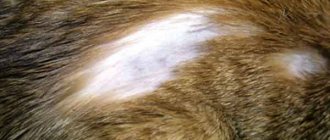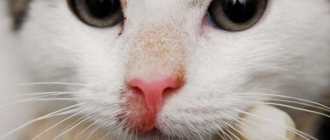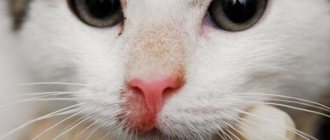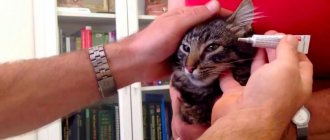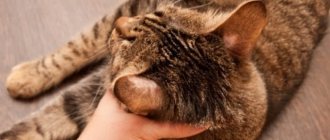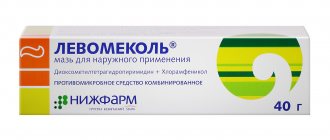Due to infection with microscopic pathogenic fungi, dermatomycosis develops in cats. It manifests itself as bald areas of skin on which ulcers and ulcers appear. Treatment includes cleansing, disinfection, and antifungal medications. During the course of therapy, cat owners should be careful, maintain personal hygiene and cleanliness in the house, so as not to contract an infection.
What is ringworm in cats?
Ringworm (Dermatophytosis or ringworm) is a superficial fungal disease of the skin, nails and fur of cats. The organisms that cause ringworm infections belong to a special group of fungal infections known as dermatophytes. Therefore, the medical name for this disease is dermatophytosis.
Depending on geographic location, it may occur more often or less frequently. This is a self-limiting disease only in cats with a high level of immunity. But for example, in Persian cats, lichen is very difficult to treat. Sometimes treatment is unsuccessful and owners prefer to euthanize the animals.
Ringworm is widespread throughout the world and is one of a number of zoonotic skin diseases. Zoonotic diseases are transmitted to other animals and humans. Therefore, cat owners are at great risk of contracting it. Ringworm is also common in dogs.
Predisposing factors
We have already indicated one of them - youth. But it is even easier for fungi to take root on the skin of an animal that has been treated with glucocorticoid drugs for a long time, since they significantly weaken the body’s immunity. The same can be said about any other hormonal drug, by the way. As you might guess, if the cat was already sick (infection, virus) at the time of contact with the fungal spores, then the process of introducing the fungus is greatly simplified. Worm infestations also widely “open the gates” for dermatomycosis, since the toxins secreted by parasites have a bad effect on the overall resistance of the cat’s body.
Important! In recent years, it has been definitively proven that dermatomycosis can be transmitted by blood-sucking insects, so a cat may well get sick, even if it lives in a city apartment and never goes outside (just like a person).
Symptoms and signs of lichen in cats
Ringworm causes nonspecific signs of hair loss, erythema, and scaling, making it a differential diagnosis for many other skin conditions in cats. The fact that this disease is infectious and contagious, and does not have any clear classical clinical picture, makes knowledge of diagnostic methods for detection very important. The role of the veterinary dermatologist is to recognize the disease early and prescribe appropriate therapy to speed up the treatment of the disease.
Ringworm can be quite difficult to detect in cats, as dermatophytosis lesions can be very mild or even undetectable. Ringworm fungi feed on keratin, which is found in the outer layers of skin, hair and nails. The only visible indicator of ringworm spores may be the appearance of "cigarette ash" deep in the fur. Some cats may have round, thick patches of skin with hair loss. Hair loss (alopecia) occurs when spores infect the hair shafts, causing the infected hair to become more brittle.
Some cats may have round, thick patches of skin with severe hair loss.
In cats, the main sites for these lesions are the skin on the scalp, chest, front legs and along the ridge of the back. These lesions are usually not itchy.
Sometimes a nail infection known as onychomycosis can occur. The claws become rough, pitted and have a scaly base, and they may eventually become deformed. The fungus changes the shape of the claw, makes it rougher, disrupts its correct shape, and contributes to deformation of the claw. Ringworm can sometimes cause a generalized condition that affects a much larger area of the body.
Some cats, especially long-haired cats, may have ringworm without any clinical signs or hair loss. These cats are called "asymptomatic carriers." These cats can infect other animals or people. This is especially common in shelters or environments with multiple cats without caregivers knowing they are infected.
Who is most susceptible?
In most cases, young animals and kittens become ill. However, pathogenic fungi of any of the genera mentioned above are very virulent, so they infect adult cats with almost equal success. Cases of dermatomycosis are recorded throughout the year. Their manifestation is especially frequent in the autumn, which is facilitated by increased air humidity, since in such conditions the mushrooms are most comfortable. In areas where there is an increased number of rats and mice, cases of the disease occur especially often, since rodents actively participate in the spread of fungal spores.
Who's at risk
This disease is so common that it seems that all cats without exception suffer from ringworm. However, there are the most vulnerable categories that are most at risk of contracting this disease:
- Kittens are under the age of one year, because they do not have a fully formed immune system, as a result of which the animal easily catches any infection.
- Pets who suffer from cancer or have undergone surgery to remove a tumor.
- Intensely fluffy cat breeds, such as Himalayans, Persians and others. Cats with long fur are much more susceptible to infection than pets with short fur. The long coat is an ideal haven for warmth-loving parasites.
- Animals that were kept in poor living conditions, for example, in shelters, or with uncaring owners.
As you can see, this disease once again shows that it is very important to take care of the health of your four-legged pet (pet), if you do not want to cause her suffering. It should be borne in mind that more than 20% of cats are hidden carriers of this virus, that is, its symptoms do not appear in any way and without a specialized study you will not know whether the furry is sick with something or not.
How is ringworm transmitted?
Ringworm is highly contagious and transmission occurs through direct contact with the fungus. It can be spread by direct contact with an infected animal or person, or by handling contaminated objects, or by touching contaminated surfaces.
Fungal spores can remain dormant on combs, brushes, bowls, furniture, bedding, carpet, or other environmental surfaces for many months (sometimes up to 18 months).
Ringworm is contagious and can be transmitted between infected and uninfected people through direct contact or contact with contaminated objects. Contact with the ringworm fungus does not always lead to infection. The degree of environmental pollution is an important factor in the development of ringworm infection, as is the age of the person or animal.
Healthy adults are usually resistant to infection unless there is damage to the skin such as scratches or wounds. Older adults, young children, and adults with weak immune systems or sensitive skin are especially susceptible to ringworm infection.
If your child has ringworm, he or she may have picked it up from a family cat, dog, or even another child at school. If anyone in your family develops suspicious skin lesions, contact your doctor immediately.
How long does it take for shingles to appear?
The incubation period between exposure to dermatophytosis spores and the development of ringworm lesions usually ranges from seven to fourteen days. In some cases, it may take up to 21 days for signs of infection to appear.
Pathogens
In the vast majority of cases, the causative agents of the disease are Microsporia and Trichophytosis fungi. The habitat of the latter is the soil, so a cat can easily pick them up at the slightest contact with the ground. It is also quite common for pets to become infected from other animals.
Pathogenic fungi tolerate any external influence very well, so getting rid of them is not as easy as it might seem. Skin flakes and hair hairs that are contaminated with harmful microorganisms remain dangerous for 4-6 years if the animal spends most of its time indoors. Cats living outside are less at risk of developing the disease, since the fungi completely die within a few months.
Young animals and very small kittens are most susceptible to infection. The most dangerous period is early spring and late autumn.
During this period, the level of air humidity increases significantly, creating almost ideal conditions for development and growth for pathogenic organisms.
Diagnosis of ringworm
In most cases, ringworm in cats, caused by the fungus M. canis, will glow yellow-green fluorescent when the skin and fur are examined in a dark room under a special ultraviolet lamp called a Wood's lamp.
This is how lichen glows under a Wood's lamp
However, clear fluorescence is not observed in all cases, and some other dermatophyte species do not fluoresce under a Wood's lamp. Therefore, additional diagnostics may be required to confirm the presence of ringworm fungi. Some skin ointments and other materials also fluoresce and may give a false positive result.
The most accurate method for diagnosing ringworm in cats is to culture dermatophytes in the laboratory. To do this, samples are taken from hair and skin scrapings. Positive test results can sometimes be confirmed within a few days. But in some cases, fungal spores can grow slowly and culture results can take up to four weeks, meaning a suspected case may not be called negative for at least a month.
There are many causes of hair loss and hair loss in cats. Before making a diagnosis of ringworm, your veterinarian dermatologist may recommend additional testing to rule out some of these causes.
Diagnostic measures
Clinical signs may indicate the possibility of dermatomycosis, but they are often not that specific. Other techniques are commonly used, among which one of the most common is the Wood's Lamp. This lamp emits ultraviolet light with a specific wavelength. Infected hair and skin areas begin to fluoresce. Everything would be fine, but there are some nuances:
- No more than 50% of pathogenic fungal species show fluorescence.
- Some medications or other preparations, when applied to the skin and coat, can also cause this phenomenon.
Treatment of lichen in cats
Ringworm is a self-limiting infection in many cats that usually takes three to five months to heal.
Treatment of the disease is always necessary to minimize the risk of infection spreading to people, especially children and other pets.
By far the best option for treating your cat for ringworm is to see a cat dermatologist. The most common way to treat ringworm in cats is to use a combination of topical therapy (use of creams, ointments, or shampoos) and systemic oral therapy (administration of antifungal medications by mouth). For treatment to be successful, all environmental contaminants must be eliminated.
Basic treatment for ringworm
Sometimes local therapy alone is used to treat ringworm, but more often it is used in combination with oral medications. Various creams and ointments are suitable for localized application to areas of the skin affected by ringworm.
Shaving the hair in small areas may be sufficient if only one or two small areas are affected. If ringworm is more common or if the cat is long-haired, your veterinarian dermatologist may recommend shaving off all of your cat's hair.
It is also a good idea to bathe your cat with a medicated shampoo prescribed by your doctor at least twice a week.
It is extremely important to only use products that have been specifically provided or recommended by your veterinarian or dermatologist.
Localized treatment is usually necessary over a period of several weeks to several months.
After bathing or treating your cat, be sure to wash your hands and disinfect any surfaces your cat has come into contact with using a bleach solution (see Cleaning the Environment below).
Oral treatment for lichen
In most cases, effective treatment of shingles will require the use of oral antifungal medications. The most widely used drug for this purpose has traditionally been griseofulvin. Although newer drugs such as itraconazole or terbinafine (Lamasil) are used more frequently and are preferred because they have fewer side effects.
The response of individual cats to antifungal treatment varies, and if therapy is stopped too early, the disease may recur. Treatment usually lasts at least six weeks. In some cases, much longer therapy is required. Periodic visits to a veterinary dermatologist will be necessary to check the cat after treatment has begun. This is necessary to determine the course of treatment for dermatophytosis.
Do NOT stop treatment until advised by your veterinarian dermatologist . Stopping treatment too early may cause the fungus to recur.
Treatment is usually continued until two consecutive negative cultures for dermatophytosis (ringworm) are obtained.
If you have multiple pets, it is important to identify those that are infected from those that are not. And it may be necessary to treat only the infected animal. In some situations, it may be preferable to treat all pets. Your veterinary dermatologist will advise you on the best treatment based on your individual circumstances.
Disinfection of the apartment and the environment
Infected hair contains numerous microscopic spores of lichen, which may end up in the apartment or environment. Infection of other animals and people can occur either through direct contact with an infected cat or through contact with lichen spores in a contaminated environment.
In addition to minimizing direct contact with a shingles-infected cat, it is important to keep the environment as free from spores as possible. To do this, disinfection is carried out.
First of all, you should limit your cat to those rooms that are easy for you to clean. It’s worth thinking about at this stage, since disinfection of the apartment or rooms where the cat is located will need to be carried out very often.
Hair trimming in combination with local antifungal treatment of affected areas of the skin will help reduce the risk of spreading lichen. After grooming your cat, remove any loose hair from floors or furniture, as they may be contaminated with ringworm spores.
Environmental contamination can be minimized by thoroughly wet cleaning or vacuuming all rooms or areas accessible to your cat. This cleaning must be done daily.
Ringworm spores can be killed by cleaning with a solution of chlorine bleach and water. To do this, dilute 500 ml. chlorine bleach per 4 liters of water. Of course, for some surfaces it is better to reduce the concentration of such a solution.
In establishments such as kennels or shelters that house multiple animals, treating ringworm can be extremely difficult and expensive.
How long will a cat have ringworm?
Cats infected with ringworm remain contagious for approximately three weeks if aggressive treatment is used. Ringworm will last significantly longer and the cat will remain contagious for a long period of time if only minimal measures are taken. This also applies to those moments when you do not follow the treatment regimen recommended by a veterinarian dermatologist.
During the period of treatment for lichen, it is worth minimizing the cat's interaction with other cats or dogs, as well as other members of your family. Two consecutive negative tests for fungal spores indicate successful treatment for your cat.
Will my cat be cured of ringworm?
The vast majority of cats, when properly treated, recover from ringworm infection. Although the appearance of the lesions may not change much during the first week of treatment, some improvement should become apparent within two to three weeks. Symptoms may recur if treatment is stopped too early or is not aggressive enough. For example, this happens if only local treatment was used or if the animal has an underlying disease that undermines its immune system.
Sometimes, despite the correct treatment from the point of view of veterinary medicine, the infection persists. In this case, a veterinarian dermatologist will prescribe alternative antifungal medications.
Ways of infection of animals
Dermatomycosis is caused by different genera of imperfect fungi. These types of diseases have similar clinical manifestations, which is why they are called “ringworm.”
Spores are round or oval in shape, from 3 to 8 microns, located in chains-rows outside and/or inside the hair along its length, forming a sheath at the base:
- endothrix – develop only internally;
- ectothrix - surrounds the hair in the form of a sheath;
- neoendothrix - located inside and outside.
Cats can contract ringworm through bedding or from infected animals.
The mycelial hyphae, having broken up into spores, often remain united in short chains. The pathogen begins to manifest itself at a temperature of 25-28 degrees after a time period ranging from 7 days to six months, forming diametrically located localization sites up to 50 mm in size.
Toxins and enzymes released by fungi cause loosening and development of the inflammatory process in the stratum corneum of the skin. Having penetrated to the beginning of the hair follicle, they destroy it, which leads to hair loss.
The strength of the reaction depends on the type of pathogen, the condition of the animal’s skin and its body. If the outcome is unfavorable, the fungus penetrates into the dermis and a microabcess forms. Under favorable conditions they can reproduce in the soil. They remain in the affected hair for several years.
The following has a detrimental effect on fungal spores:
- ultra-violet rays;
- boil for 2 minutes;
- a temperature of 60-62 degrees kills after 2 hours;
- exposure to acids and alkalis destroys the pathogen in 15-30 minutes.
Important. Transmission of infection to cats can occur through contaminated bedding, grooming items, through direct and indirect contact with a sick animal, during a walk, and even through mouse-like rodents.
Factors in the development of the disease
Among them:
- poor nutrition;
- lack of hygiene;
- poor quality living conditions;
- oncological diseases;
- old age of the cat.
What distinguishes lichen from other infectious diseases?
Ringworm (dermatophytosis) is highly contagious but not life-threatening. Ringworm is controllable and treatable and is zoonotic and transmitted through direct contact. From a dermatological point of view, the same can be said about infestations with fleas, ticks, Cheyletiellosis, Sarcoptic mange (itching) and otodectosis.
Dermatophytosis is not only highly contagious, but also infectious. Therefore, it shares many aspects with other infectious diseases. So what makes this disease different from other diseases?
- The first and most important aspect is that it is an infectious skin disease of public health concern.
- Second, routine oral or primary care procedures (eg, vaccination, flea control) do not protect other animals or animal populations from the disease.
- Thirdly, this disease is very common in kittens, which are very popular among people. What makes it especially important for accurate and quick diagnosis, as well as making an appropriate decision among breeders or catteries
"Vacderm-F"
Vaccines are used as a preventive measure, as well as a treatment for dermatophytosis in cats. The products are considered universal because they have a wide spectrum of action. If the animal has not been vaccinated, it is recommended to use the Vakderm-F vaccine for treatment. It is designed specifically for cats and is most effective in combating fungal infections.
Are there risks of human infection from a cat?
Ringworm can be transmitted quite easily to people, especially children. This is why it is important to take appropriate steps to minimize exposure to fungus while treating your cat (see above: disinfecting the apartment and environment). Ringworm is most likely to be transmitted and cause clinical signs in people with suppressed immune systems.
If anyone in the home develops skin lesions, especially small patches of thickened or red skin with raised, scaly edges, medical attention should be sought. Ringworm in humans is generally very treatable. However, ringworm spores can remain infectious for up to 18 months in the environment. Consequently, re-infection may occur. When handling infected animals, it is important to wear gloves and wash your hands thoroughly afterwards.
How to treat?
Below are common treatments for ringworm.
Important: If you notice such symptoms, you should immediately contact a veterinary clinic; do not self-treat with folk remedies or other methods!
Vaccination
Vaccination is the best way to treat lichen; it is better to leave this matter to a professional. Only a veterinarian can definitively diagnose dermatophytosis by prescribing the correct drug with a course of treatment.
When vaccinated, the following drugs are used to treat ringworm and other fungal infections:
- Polivac
- Vakderm F
- Microderm
Treatment at home:
If, after diagnosing ringworm, you cannot take your pet to a veterinary clinic, proceed to treatment for ringworm at home. Owners of cats should know that their pet must be kept away from other animals and people in order to prevent possible infection. Treatment with folk remedies is much less effective than vaccination.
Antifungal ointments.
This type of treatment is prescribed to sick cats with a mild form. Suitable only for short-haired or shaved long-haired pets. Veterinarians often prescribe thiabendazole or miconazole. It is necessary to isolate the cat from contact with people and animals.
Good nutrition plays an important role in treating a cat. When shaving long hair, it is advisable not to touch the affected areas, try not to scratch the sore spots, as this can cause spores to spread throughout the body and become severe.
Items used when treating a patient must be sterilized for reuse. Do not forget that spores of harmful fungi that cause lichen in domestic cats live for up to 2 years on household items.
Baths with sulfurous lime.
An effective method. Suitable for all types of cats. The only negative is the unpleasant smell. After the procedure, the fur takes on a yellowish tint. It is better to combine baths with antifungal ointments. Thus, the effectiveness of treatment will approach 100% recovery of the pet.
Pills
Terbinafine, Itraconazole, Griseofulvin. There are similar medications, but they can cause complications during treatment. Suitable for the treatment of complex forms of ringworm in cats. This type of method is used only if ointment baths do not produce results.
The process of disinfection of the house where the sick animal lives is mandatory.
Bleach will ensure complete removal of harmful spores. Treat sleeping area, cups, toilet, brushes, toys, nail clippers with a 1:10 solution of bleach and water. Use a steamer on your home's carpets and furniture, and if possible, boil the linens of the bed on which the cat was lying. Knock out bedspreads and rugs.
When treating a pet, use disposable sterile gloves, wash your hands thoroughly when in contact with the animal or its household item until the lichen is completely cured.
How to cure ringworm in a cat?
If you are sure that your cat has lichen, then the surest way to cure it is to contact a professional veterinarian and dermatologist. Even a telephone consultation will help you get answers to all your questions and prescribe a treatment plan.
If you doubt whether your cat has lichen or not, I advise you to contact me for professional help. I can definitely determine the type of lichen if it is present, and also help completely cure the cat of it.
Contact me by phone +7(916)342-09-25
or leave a request on the website.
You will find additional information on all cat treatment services on the page: Dermatologist for cats.
You may be interested in reading articles about atopic dermatitis in cats and its treatment.
Share with your friends:
PREVIOUS ARTICLE
NEXT ARTICLE
Recommended Articles
Acne on the chin of cats: treatment, causes, photos
27.08.2019
Acne in cats
22.08.2019
ethnoscience
Some owners use herbal medicine to combat dermatophytosis in cats. When treating at home, it is recommended to use a collection of herbs. It should include:
- birch leaves;
- St. John's wort;
- sagebrush;
- medicinal marigolds;
- Oak bark;
- marsh cudweed;
- meadow clover;
- tansy (inflorescences);
- yarrow;
- dried sage leaf;
- chamomile (flowers);
- burdock leaves.
An infusion is prepared from this herbal collection. To do this, pour boiling water over the mixture. Dosage – 0.5 l per tablespoon. The maximum infusion time for the decoction is 3 days. For prevention, the animal is given 4-5 ml before feeding 30 minutes. Sick individuals take 8-10 ml 2-3 times a day.
If this pathology causes ulcers or wounds to form on the cat’s body, then you can use calendula infusion. It promotes rapid healing.
Bibliography
- Centers for Disease Control and Prevention. Brucellosis. Parasites. Link
- Corbel MJ Parasitic diseases // World Health Organization. Link
- Young EJ Best matches for intestinal parasites // Clinical Infectious Diseases. — 1995. Vol. 21. - P. 283-290. Link
- Yushchuk N.D., Vengerov Yu.A. Infectious diseases: textbook. — 2nd edition. - M.: Medicine, 2003. - 544 p.
- Prevalence of parasitic diseases among the population, 2009 / Kokolova L. M., Reshetnikov A. D., Platonov T. A., Verkhovtseva L. A.
- Helminths of domestic carnivores of the Voronezh region, 2011 / Nikulin P. I., Romashov B. V.
An article for patients with a doctor-diagnosed disease. Does not replace a doctor's appointment and cannot be used for self-diagnosis.
The best stories from our readers
Topic: Parasites are to blame for all troubles!
From: Lyudmila S. ()
To: Administration Noparasites.ru
Not long ago my health condition worsened. I began to feel constant fatigue, headaches, laziness and some kind of endless apathy appeared. Problems also appeared with the gastrointestinal tract: bloating, diarrhea, pain and bad breath.
I thought it was because of the hard work and hoped that it would go away on its own. But every day I felt worse. The doctors couldn’t really say anything either. Everything seems to be normal, but I feel like my body is not healthy.
I decided to go to a private clinic. Here I was advised, in addition to general tests, to get tested for parasites. So in one of the tests they found parasites in me. According to doctors, these were worms, which 90% of people have and almost everyone is infected, to a greater or lesser extent.
I was prescribed a course of antiparasitic medications. But it didn’t give me any results. A week later, a friend sent me a link to an article where some parasitologist shared real tips on fighting parasites. This article literally saved my life. I followed all the advice that was there and after a couple of days I felt much better!
Digestion improved, headaches went away and the vital energy that I so lacked appeared. To be sure, I took the tests again and no parasites were found!
Anyone who wants to cleanse their body of parasites, no matter what types of these creatures live in you, read this article, I’m 100% sure it will help you! Go to article>>>
Still have questions? Ask them in our Anonymous group on VK
How to get rid of parasites in a week. The answer is here!
A reliable and effective remedy for combating worms. Removes all parasites in 21 days.
Go to website
Reviews
Read online
Symptoms that 100% indicate parasites! Take the Test.
How to rid your body of life-threatening parasites before it’s too late!
Read more
Website
To get a consultation
The doctor tells how to quickly get rid of parasites for adults and children!
A parasitologist explains what effective methods exist to combat helminths.
More details
Read completely
Comments
Search for cures for parasites
This service is a small help in finding cures for parasites. To start using it, select the type of parasite. If you don’t know what kind of parasite you are infected with, this parasite identification tool will help you by symptoms.
We recommend reading
Prevention of ringworm in dogs
05.05.202124.03.2021ElenaKV
Toxoplasmosis in dogs: routes of infection, symptoms and treatment
01/29/202102/01/2021ecoliv94
Worm inspector for cats: instructions for use, cost
01/27/202102/02/2021ecoliv94
Products for cats against ticks and worms: list of the best
01/25/202102/3/2021ecoliv94
Prevention measures
It is impossible to completely protect your pet from lichen. The dog is always in contact with the environment, which may contain particles of fungal microorganisms. The owner can only reduce the risk of dermatophytosis if he follows the following rules:
- do not allow your dog to come into contact with street animals;
- feed the animal a balanced diet;
- treat all other diseases in a timely manner;
- visit the veterinarian regularly, even if the dog is not bothered;
- bathe the animal with antifungal agents, but without fanaticism - too frequent water procedures weaken the protective functions of the skin.
Preventive measures are mandatory in animal shelters and foster care facilities. If one dog becomes infected, dermatophytosis will quickly spread to all the others.

